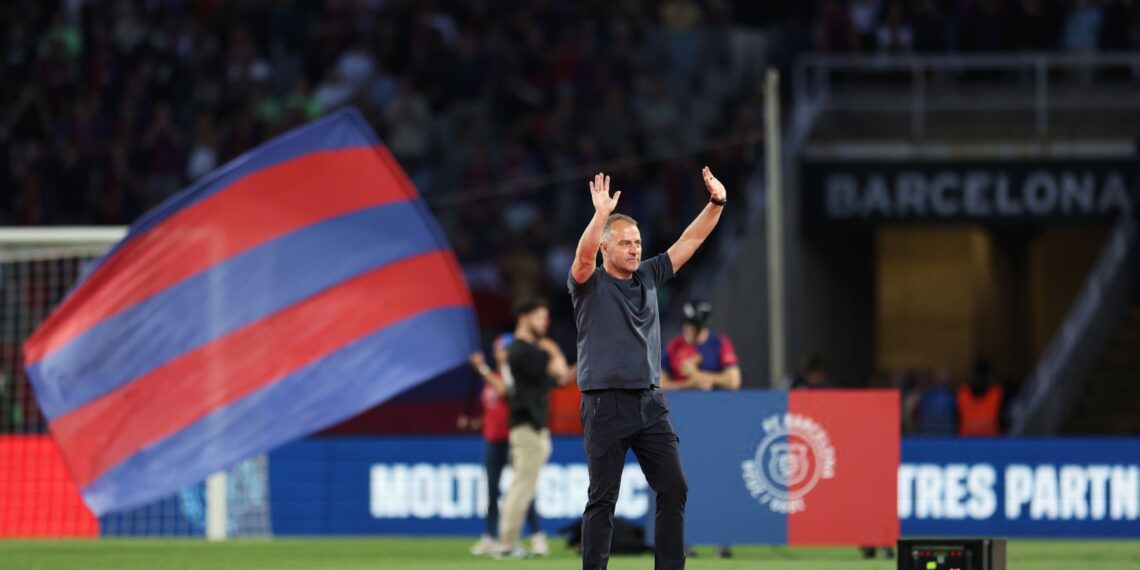A year makes all the difference in football. Twelve months ago, Barcelona’s aggressive high line was the talk of European football—a tactical innovation so effective it seemed to give Hansi Flick’s side an almost unfair advantage. On Thursday, following a chaotic 3-3 Champions League draw with Club Brugge, that same defensive approach has become Barcelona’s most scrutinized weakness, raising urgent questions about whether the Catalan giants have become predictable victims of their own tactical identity.
Table of Contents
The Glory Days: When Barcelona’s Offside Trap Was Unstoppable
The zenith of Barcelona’s high-line dominance came on October 26, 2024, when they demolished Real Madrid 4-0 at the Santiago Bernabéu in one of the most tactically dominant Clásico performances in recent memory. That match encapsulated everything brilliant about Flick’s approach—and inadvertently set the stage for current concerns.
| Historic Clásico Achievements (Oct 26, 2024) | Significance |
|---|---|
| 4-0 victory margin | Joint-biggest La Liga away win vs Real Madrid in 21st century |
| Lamine Yamal’s goal | Youngest Clásico goalscorer ever (17 years, 105 days) |
| Hansi Flick’s debut | First manager to win debut Clásico by 4+ goals since 1995 |
| Real Madrid’s streak broken | Prevented Madrid equalling Barcelona’s 43-match unbeaten record |
Yet the post-match discourse focused less on Barcelona’s brilliance and more on Real Madrid’s frustration—specifically, Kylian Mbappé’s humiliation at the hands of Barcelona’s offside trap. The French superstar was caught offside eight times, the most by any player in a single top-five European league match since Sergio Pellissier’s ten offsides for Chievo against Roma in December 2010.
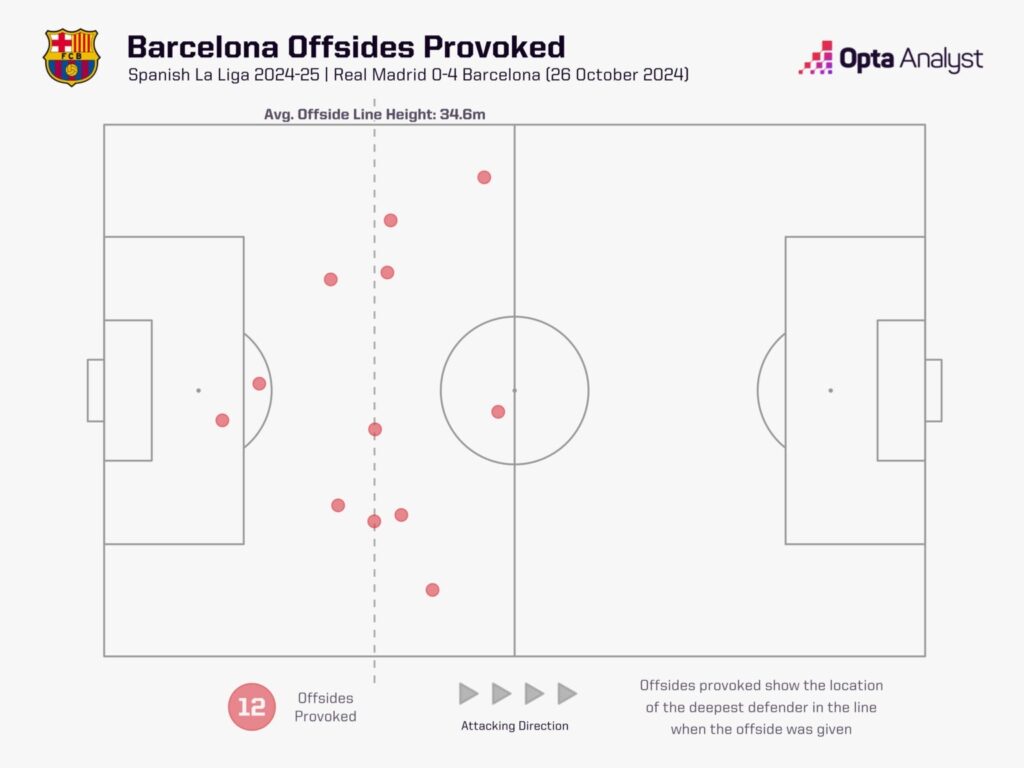
Six of Mbappé’s offsides occurred in the first half alone, accounting for 75% of Real Madrid’s offside calls before the break. The eight first-half offsides against Madrid equalled their joint-most on record since 2003-04, while their 12 total offsides for the match represented their highest tally in a league game since March 2013.
Barcelona’s Offside Trap: The Numbers Behind The System
To understand how dramatically Barcelona’s high line dominated last season, consider the statistical anomaly they created. After that Clásico victory, Barcelona were provoking 7.0 offsides per game—an almost incomprehensible figure that dwarfed every other team in Europe’s top five leagues.
| Barcelona’s Offside Trap Dominance (2024-25 Season) | Statistics |
|---|---|
| Offsides provoked after Clásico | 77 total |
| Combined 2nd + 3rd place teams | 70 total (less than Barcelona alone) |
| Full season average | 4.8 offsides per game |
| Historical comparison | 10% higher than any team since VAR introduction (2017-18) |
| Average distance from goal | 33.8m (highest in La Liga by 2m) |

Even when Barcelona’s offside-provoking rate declined slightly over the full season—possibly due to opposition tactics or personnel issues—their 4.8 offsides per game remained almost 10% higher than any other team had managed over a complete season since VAR’s introduction in 2017-18. They won La Liga as part of a domestic treble, with their high line playing an undeniable role in that success.
The Unraveling: When The High Line Becomes A Highway
Fast forward to November 2025, and the narrative surrounding Barcelona has shifted dramatically. Wednesday’s 3-3 Champions League draw with Club Brugge—a team Barcelona should have beaten comfortably—exposed vulnerabilities that have become increasingly apparent this season.
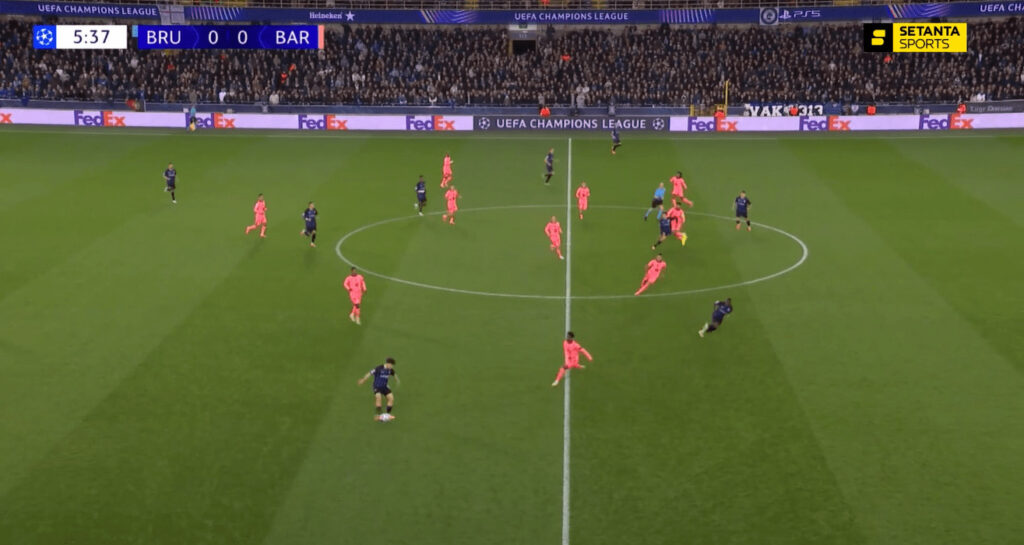
All three goals Barcelona conceded in Belgium stemmed at least partially from their high line. Carlos Forbs exploited the space in behind repeatedly, scoring twice and assisting another. On Brugge’s opener, Barcelona’s backline reacted slowly to Forbs’ run down the right, with Jules Koundé playing him onside. The winger galloped clear and teed up Nicolò Tresoldi for a simple finish.
Hansi Flick’s post-match assessment was telling: “I think when you see their first goal, last season, for me, that’s 100% offside. This season, we struggle a little bit; we do not have the confidence. When there is no intensity, you have no chance in the Champions League.”
The Brugge debacle wasn’t isolated. A pattern of vulnerability has emerged throughout the 2025-26 campaign:
October: Sevilla 4-1 Barcelona – Three goals came via quick, direct attacks against Barcelona’s high defense from a mediocre Sevilla side that subsequently lost three straight matches.
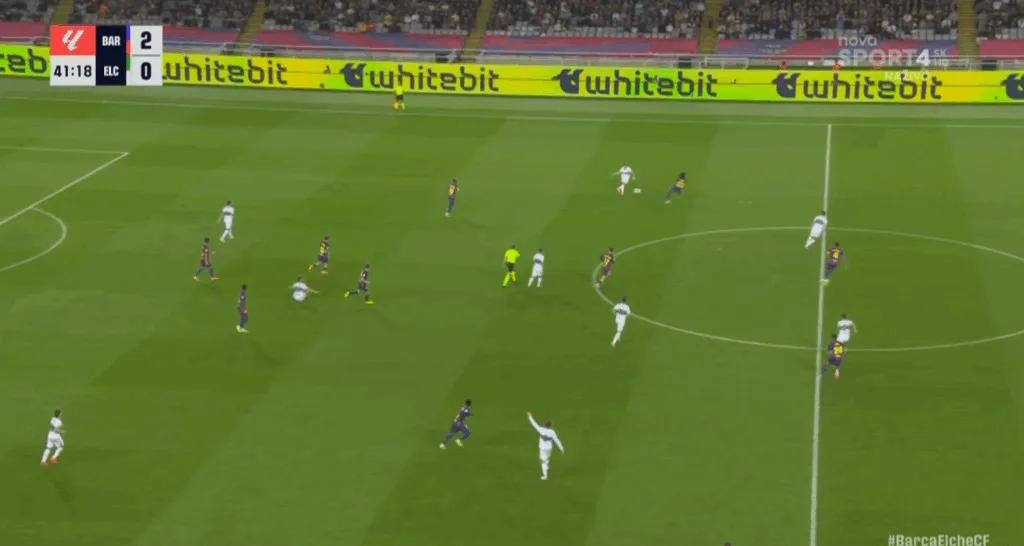
Recent weekend: Elche vs Barcelona – Rafa Mír ran from the halfway line, breaking Barcelona’s offside trap to score.
August: vs Levante – Iván Romero’s brilliant opener caught Barcelona’s backline retreating toward their own goal.
The Statistical Reality: Still Effective But More Vulnerable
The paradox of Barcelona’s current situation is that their high line remains statistically effective in isolation—they’ve provoked more offsides than any other team in Europe’s top five leagues this season:
| Barcelona’s 2025-26 Offside Statistics | La Liga | Champions League |
|---|---|---|
| Total offsides provoked | 54 (most in Europe) | 7 (4 games played) |
| Per-game average | 4.91 | 1.75 |
| Average distance from goal | 31.6m | 22.2m |
| Comparison to last season | Slightly closer (33.8m in 2024-25) | Much closer (risk increased) |
Barcelona actually catch opponents offside more frequently per game in La Liga this season (4.91) than they did over the full 2024-25 campaign (4.8). However, context matters: their current rate represents a significant drop from the 7.0 per-game average they maintained at this point last season—that astronomical figure being the anomaly that made them appear invincible.

The concerning trend emerges when examining where Barcelona defend. While their La Liga positioning remains aggressive (31.6m from goal), they trail Real Madrid (34.6m) and Atlético Madrid (32.6m) yet have provoked 46 and 44 more offsides respectively than those rivals. In the Champions League, their offsides occur just 22.2m from goal—a dangerously high line against elite opposition.
The Cost: Goals Conceded From Transitions
The true measure of tactical vulnerability isn’t offsides provoked but goals conceded. Here, the statistics paint a troubling picture for Barcelona:
| Goals Conceded Comparison | 2024-25 | 2025-26 | Change |
|---|---|---|---|
| Champions League direct attacks | 1 in 14 games | 2 in 4 games | +100% increase rate |
| La Liga direct attacks (per game) | 0.21 | 0.18 | Slight improvement |
| La Liga fast break shots (per game) | 1.05 | 1.36 | +29.5% increase |
| La Liga fast break goals (per game) | 0.21 | 0.36 | +71.4% increase |
The numbers confirm what the eye test suggests: Barcelona look significantly more susceptible to transitions and counters than in 2024-25. They’re facing 29.5% more shots from fast breaks in La Liga and conceding 71.4% more goals from such situations. If you’ve watched Barcelona this season feeling they’re more vulnerable on the counter, you’re absolutely right.
What Changed? The Iñigo Martínez Factor
Pinpointing one exact cause for Barcelona’s defensive regression is difficult, but several factors stand out. Chief among them: the summer departure of Iñigo Martínez to Al Nassr in Saudi Arabia.

Martínez was Barcelona’s most experienced center-back and a key figure in making Flick’s high line function last season. His comments to COPE last month were revealing: “For [Flick], I think I was a key piece, and when I left, the puzzle broke a little.”
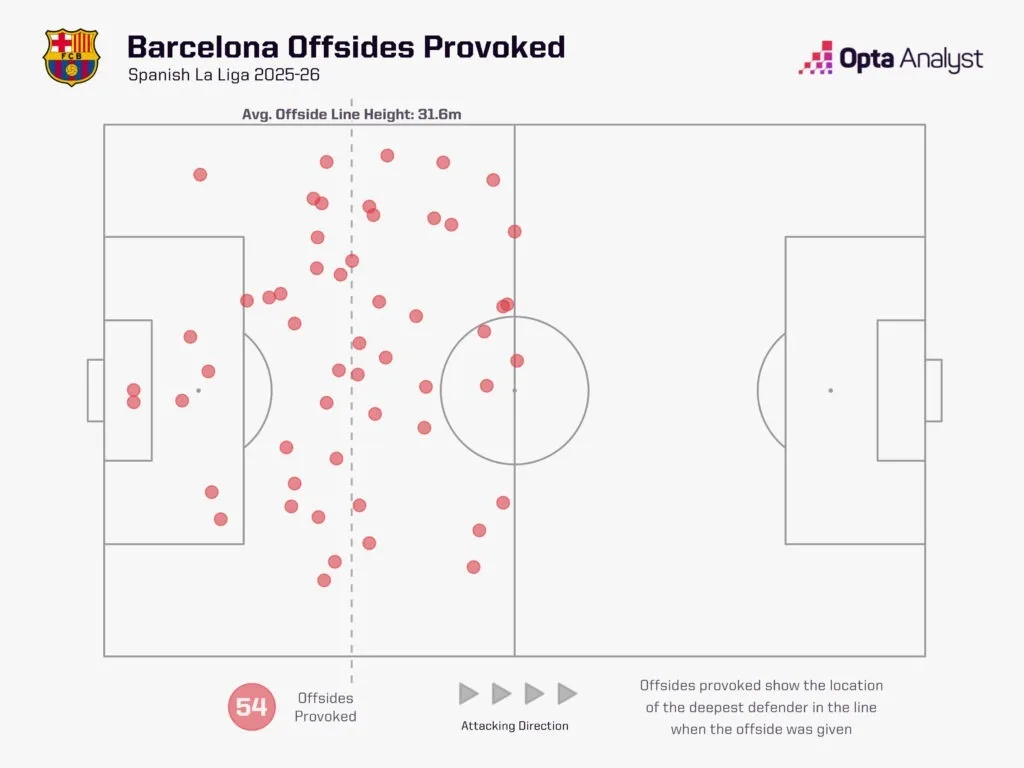
Experience matters in executing a high line. Martínez understood positioning, timing, and communication—intangibles that can’t be replaced simply by inserting another defender. His departure left Barcelona without a vocal, experienced marshal organizing the backline under pressure.
The Injury Crisis: Disruption To The Press
Barcelona’s team has faced significant disruption this season through injuries, particularly impacting their ability to execute Flick’s high press—the first line of defense for a high defensive line.
Key absences:
- Raphinha: Played only 7 of 15 possible games across league and Champions League. His pressing was vital to the system’s effectiveness.
- Robert Lewandowski: Missed at least 4 games, disrupting attacking patterns.
- Lamine Yamal: Absent for multiple matches, removing Barcelona’s most dangerous attacking threat.
When a well-drilled front three faces constant disruption, the knock-on effects cascade backward. The midfield becomes less protected, winning fewer duels and applying less pressure. This exposes the high line to exactly the scenario it cannot handle: organized opponents with time and space to play penetrating passes.
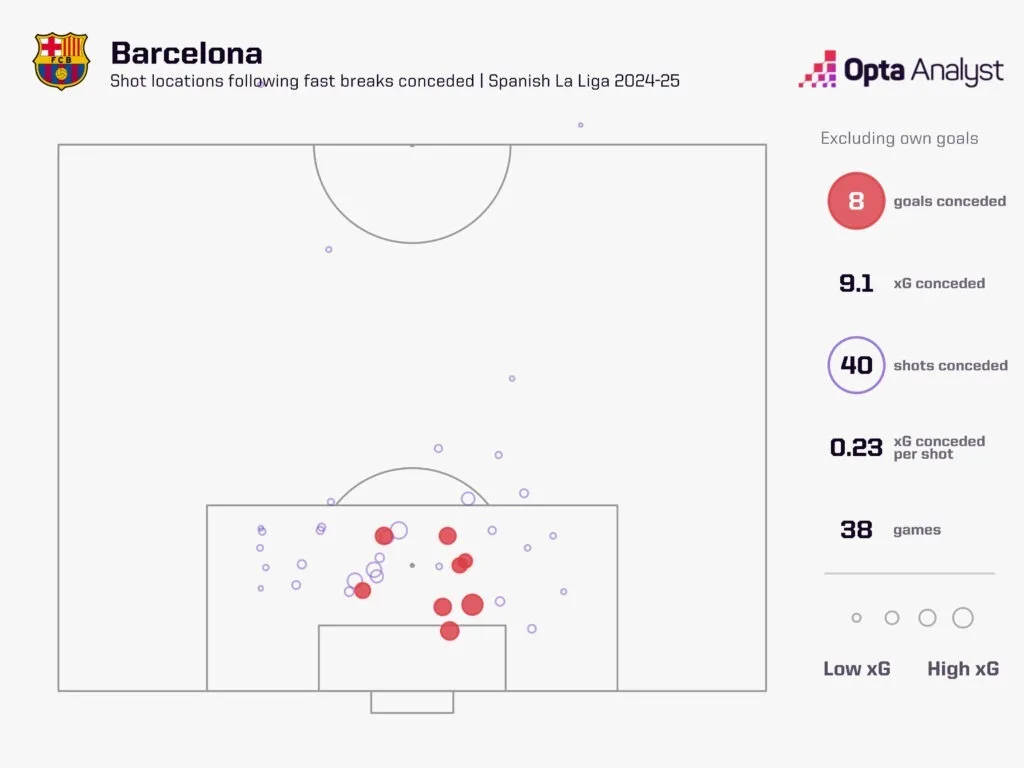
Flick acknowledged this explicitly after the Brugge draw: “In midfield, we don’t have the pressure on the ball and we don’t win the duels, so it’s not easy for our last line to defend these fast players. We have to work on that, analyse everything.”
Flick’s Defiant Stance: Philosophy Over Pragmatism
Despite mounting evidence that opponents have identified and are exploiting Barcelona’s defensive approach, Hansi Flick remains adamant he won’t abandon his principles.
“We could do it like this, play a low block and defend in the first third, or we go on our way, our philosophy, how we want to do it and do things much better,” Flick stated after the Brugge match. “We can speak about changing everything, but I am not the coach for this. We want to play to our DNA; we don’t want a low block and transitions to win 1-0.“

This ideological commitment raises questions. A year ago, Flick insisted his high-line approach “isn’t risky.” Today, with Barcelona conceding from transitions at alarming rates, that assertion appears increasingly misplaced.
Flick maintains the problem is internal execution rather than opponents outfoxing his system: “At the moment, sometimes, we get it wrong, [but] this is not about the philosophy.“
The Tactical Dilemma: Adaptation vs Identity
Barcelona face a philosophical crossroads. Do they:
- Persist with the high line, believing better execution will restore last season’s dominance
- Modify the approach, dropping deeper when personnel or match situations demand it
- Accept the trade-off, recognizing that a high line creates both chances and vulnerabilities
The answer likely lies somewhere between rigid ideology and total abandonment. Elite teams adapt while maintaining core principles. Barcelona’s high line isn’t inherently flawed—it won them a treble. But refusing to modify it when key personnel are absent or opponents specifically target it represents tactical stubbornness.
The irony is that Barcelona provoke more offsides than anyone in Europe, yet concede more goals from transitions than last season. Their high line still catches opponents offside frequently; it’s the times it fails that have become more costly.
Tactical Evolution Or Stubborn Regression?
Barcelona’s high line transformed from tactical innovation to tactical vulnerability in twelve months. The system that embarrassed Real Madrid and delivered a domestic treble now struggles against opposition that has identified its weaknesses and developed specific counter-strategies.
The question isn’t whether Barcelona’s high line is fundamentally broken—statistics show it still provokes offsides at elite rates. Rather, the question is whether Hansi Flick will adapt his approach to account for changed circumstances: the loss of Iñigo Martínez’s experience, injury disruption to the pressing system, and opponents who’ve studied hundreds of hours of footage identifying exploitation patterns.
Football evolves. Last season’s innovation becomes this season’s predictability unless coaches evolve with it. Barcelona remain an excellent team, but their high line—once their greatest strength—has become the weakness opponents specifically target.
Whether Flick’s ideological commitment to his philosophy represents admirable principle or stubborn inflexibility will determine Barcelona’s trajectory. For now, the high line that once trapped Real Madrid in an offside cage has become a highway opponents sprint down with increasing frequency and success.
FAQs
How many offsides does Barcelona provoke compared to other European teams?
Barcelona lead Europe’s top five leagues with 54 offsides provoked this season (4.91 per game), significantly more than any other team, though down from their 7.0 per-game peak last season.
What was significant about Barcelona’s Clásico win over Real Madrid in 2024?
Barcelona won 4-0 at the Bernabéu with Real Madrid caught offside 12 times (most in a Clásico since at least 2003-04). Kylian Mbappé was caught offside eight times personally.
Why has Barcelona’s high line become more vulnerable this season?
Key factors include Iñigo Martínez’s departure to Al Nassr, injury disruption affecting the pressing system (Raphinha, Lewandowski, Yamal absences), and opponents developing specific counter-strategies.
How much more are Barcelona conceding from fast breaks this season?
Barcelona face 29.5% more shots from fast breaks (1.36 vs 1.05 per game) and concede 71.4% more goals from such situations (0.36 vs 0.21 per game) compared to last season.
Will Hansi Flick change Barcelona’s high-line approach?
Flick has stated firmly he won’t abandon the philosophy, saying “I am not the coach for this” when asked about playing deeper, insisting execution rather than the system is the problem.

